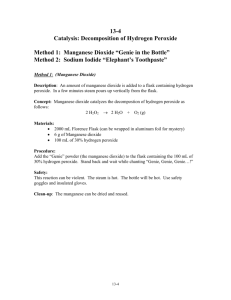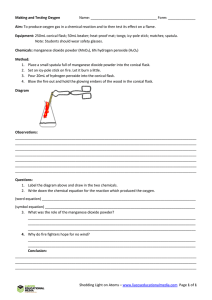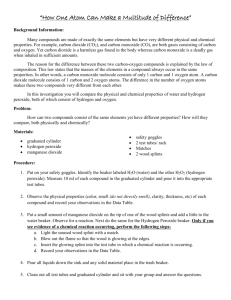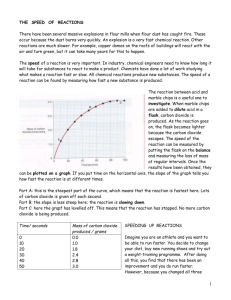A CHEMICAL GENIE
advertisement
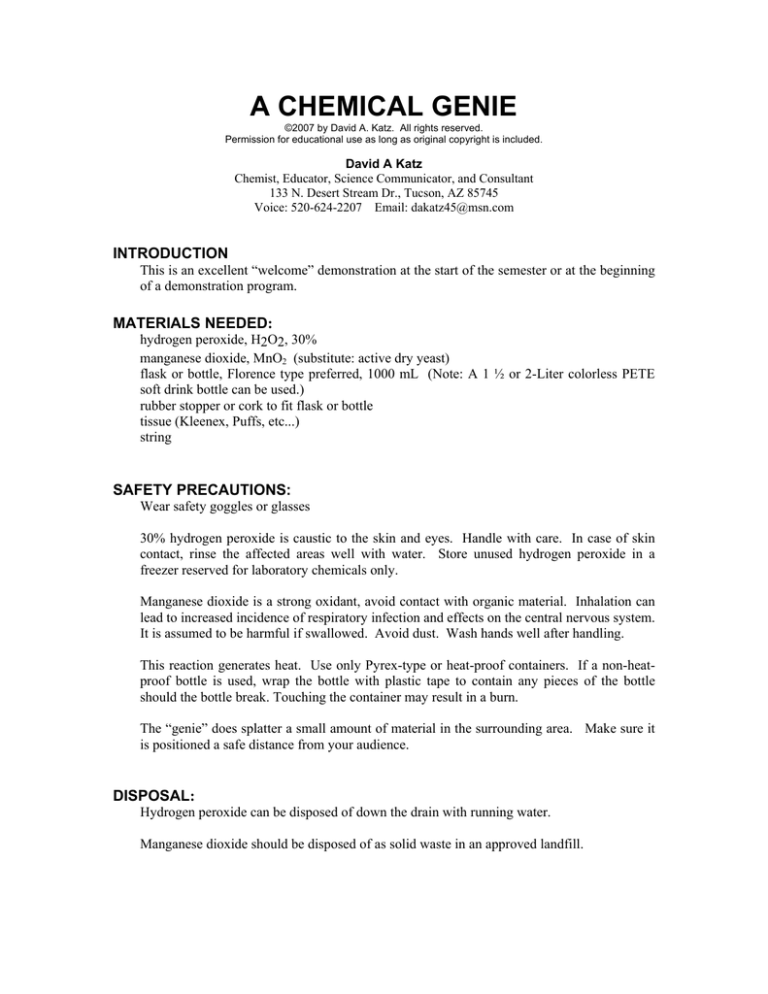
A CHEMICAL GENIE ©2007 by David A. Katz. All rights reserved. Permission for educational use as long as original copyright is included. David A Katz Chemist, Educator, Science Communicator, and Consultant 133 N. Desert Stream Dr., Tucson, AZ 85745 Voice: 520-624-2207 Email: dakatz45@msn.com INTRODUCTION This is an excellent “welcome” demonstration at the start of the semester or at the beginning of a demonstration program. MATERIALS NEEDED: hydrogen peroxide, H2O2, 30% manganese dioxide, MnO2 (substitute: active dry yeast) flask or bottle, Florence type preferred, 1000 mL (Note: A 1 ½ or 2-Liter colorless PETE soft drink bottle can be used.) rubber stopper or cork to fit flask or bottle tissue (Kleenex, Puffs, etc...) string SAFETY PRECAUTIONS: Wear safety goggles or glasses 30% hydrogen peroxide is caustic to the skin and eyes. Handle with care. In case of skin contact, rinse the affected areas well with water. Store unused hydrogen peroxide in a freezer reserved for laboratory chemicals only. Manganese dioxide is a strong oxidant, avoid contact with organic material. Inhalation can lead to increased incidence of respiratory infection and effects on the central nervous system. It is assumed to be harmful if swallowed. Avoid dust. Wash hands well after handling. This reaction generates heat. Use only Pyrex-type or heat-proof containers. If a non-heatproof bottle is used, wrap the bottle with plastic tape to contain any pieces of the bottle should the bottle break. Touching the container may result in a burn. The “genie” does splatter a small amount of material in the surrounding area. Make sure it is positioned a safe distance from your audience. DISPOSAL: Hydrogen peroxide can be disposed of down the drain with running water. Manganese dioxide should be disposed of as solid waste in an approved landfill. PROCEDURE: Prepare ahead: Put a small amount of manganese dioxide, approximately 1/8 teaspoon, on a piece of tissue paper, and tie with string to make a small sack. Cut off excess paper. Place about 50 to 100 mL of 30% hydrogen peroxide into a 1000 mL Florence flask or a bottle. Place the tissue paper sack of manganese dioxide into the neck of the flask and use a rubber stopper to hold the string so that the sack does not fall into the liquid. Cut off excess string. DO NOT STOPPER TOO TIGHT. When the stopper is removed, the paper sack containing the manganese dioxide will fall into the hydrogen peroxide solution and a chemical “genie” will be produced. EXPLANATION: This reaction is the catalytic decomposition of hydrogen peroxide: 2 H2O2 → 2 H2O + O2 Other catalysts that can be used are potassium iodide, KI, raw liver, and active dry yeast. The “genie” that is observed is actually a fog of condensing water vapor mixed with oxygen gas. In most instances, this particular reaction cannot be used to show the production of oxygen by the glowing splint test due to the large amount of water vapor produced. The large amount of water vapor in the flask or container will usually cool the glowing splint so that it does not reach the ignition temperature. UTILIZATION AND VARIATIONS: I always ask my audience “Did you see a genie?” The adults may say “yes”, but the youngsters usually say “no”. If the reply was “yes”, I usually say “Did you really see a genie?” and, then, “What did you really see?” The most common reply to that is “smoke”. At that point, I explain that they saw condensing water vapor which is commonly called a fog. I then tell the audience about the chemical reaction that occurred in the container. This demonstration should be repeated on a smaller scale with some 6% hydrogen peroxide to show the production of oxygen by the glowing splint test. (See Preparation of Oxygen) This can be followed by a discussion of burning/oxidation. Ask your class, Does iron burn? as you heat, in turn, a frying pan, a piece of steel wool, and powdered iron. (Remember, let the class tell you their observations.) A discussion of particle size also follows this demonstration. Try a dust explosion with lycopodium powder dispersed in air in a closed container (such as a paint can) and ignited. I also like to follow this series of demonstrations with some reference to carbon dioxide by pouring out a candle. As discussion of common gases would not be complete without a demonstration of the preparation and properties of hydrogen. ACKNOWLEDGEMENT: The author wishes to thank Ron Perkins, formerly from Greenwich High School, for this demonstration.


